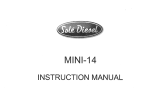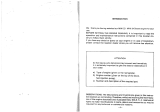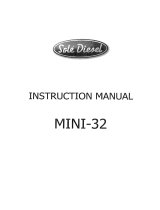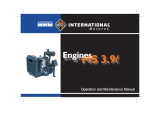
14 109821_0508
(2) Coolant Temperature
The engine performance is adversely affected if engine
coolant temperature is too hot or too cold.
The normal coolant temperature is 75 to 90°C (167 to
194°F).
Overheating
WARNING: If the Engine Coolant Temperature
Gage shows an overheat condition or you have
other reason to suspect the engine may be over-
heating, continued operation of the engine (other
than as spelled out here) even for a short period of
time may result in a fire and the risk of personal
injury and severe equipment damage.
If you see or hear escaping steam or have other reason to
suspect there is a serious overheat condition, stop and park the
equipment as soon as it is safe to do so and then turn off the
engine immediately and get out of the equipment.
The engine cooling system may overheat if the engine
coolant level is too low, if there is a sudden loss of engine
coolant (such as hose splitting), or if other problems occur. It
may also temporarily overheat during severe operating condi-
tion such as:
1. Climbing a long hill on a hot day.
2. Stopping after high rpm.
If the Engine Coolant Temperature Gage shows an over-
heat condition, or you have reason to suspect the engine may
be overheating, take the following steps:
1. If your air conditioner (if equipped) is on, turn it off. And
turn on the heater.
2. Don't turn off your engine.
3. With the transmission in Neutral, increase the engine
speed to about one-half full operating speed or 1200
RPM, maximum. Bring the idle speed back to normal
after five minutes.
If the engine coolant temperature does not start to drop
within a minute or two:
4. Let the engine run at normal idle speed for two or three
minutes. If the engine coolant temperature does not start
to drop, turn off the engine and get out of the equipment
then proceed as follows:
WARNING: To help avoid being burned -
1. Do not open the engine access cover if you see
or hear steam or engine coolant escaping from the
engine compartment. Wait until no steam or
engine coolant can be seen or heard before open-
ing the engine cover.
2. Do not remove the radiator cap or engine cool-
ant reserve tank cap if the engine coolant in the
tank is boiling. Also do not remove the radiator
cap while the engine and radiator are still hot.
Scalding fluid and steam can be blown out under
pressure if either cap is taken off too soon.
If no steam or engine coolant can be seen or heard, open
the engine access cover. If the engine coolant is boiling, wait
until it stops before proceeding. Look at the see-through
reserve tank. The engine coolant level should be between the
"MAX" and "MIN" marks on the reserve tank. If necessary,
pour engine coolant into the reserve tank only, never directly
into the radiator. Also, do not check engine coolant level at
the radiator.
Make sure the fan belts are not broken, or off the pulleys,
and that the fan turns when the engine is started.
If the engine coolant level in the reserve tank is low, look
for leaks at the radiator hoses and connections, heater hoses
and connections, radiator, and water pump. If you find major
leaks, or spot other problems that may have caused the engine
to overheat, do not run the engine until these problems have
been corrected. If you do not find a leak or other problem,
carefully add engine coolant to the reserve tank. (Engine
coolant is a mixture of ethylene glycol antifreeze and water.
See "Engine Care in cold season" in Section 8 for the proper
antifreeze and water mixture.)
WARNING: To help avoid being burned, do not
spill antifreeze or engine coolant on the exhaust
system or hot engine parts. Under some condi-
tions the ethylene glycol in engine coolant is com-
bustible.
If the engine coolant level in the reserve tank is at the cor-
rect level but there is still an indication on the instrument
panel of an overheat condition:
You must let the engine cool first. You may then add
engine coolant directly to the radiator.
Once the Engine Coolant Temperature Gauge no longer
indicates an overheat condition, you can resume operating at a
reduced speed. Return to normal operating after about ten
minutes if the gage pointer does not again show an overheat
condition.
If no cause for the overheat condition was found, see a
qualified service technician.
Overcooling
The engine operation at low coolant temperature will not
only increase the oil and fuel consumption but also will lead
to premature parts wear which may result in engine failure.
(3) Engine Hour meter (Engine Operation Hour Indi-
cating) (If so equipped)
This meter indicates the engine operation hours. Make
sure that the meter is always working during engine opera-
tion.
Periodic engine maintenance is scheduled based on operat-
ing hours indicated on the hourmeter.
(4) Liquid and Exhaust Leakages
Check for lubricant, fuel, coolant and exhaust leaks.
























